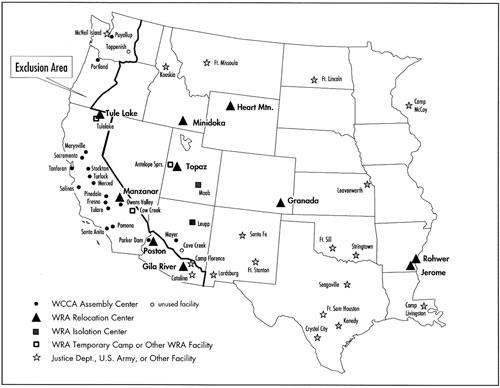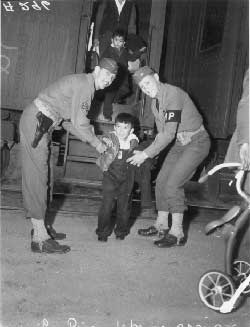MENU
|
| |
Confinement and Ethnicity: An Overview of World War II Japanese American Relocation Sites by J. Burton, M. Farrell, F. Lord, and R. Lord |

|
|
| |
Chapter 1
Sites of Shame: An Introduction
In 1942, almost 120,000 Japanese Americans were forced from their homes in California, western Oregon and Washington, and southern Arizona in the single largest forced relocation in U.S. history. Many would spend the next 3 years in one of ten "relocation centers" across the country run by the newly-formed War Relocation Authority (WRA). Others would be held in facilities run by the Department of Justice and the U.S. Army (Figure 1.1). Since all Japanese Americans on the west coast were affected, including the elderly, women, and children, Federal officials attempted to conduct the massive incarceration in a humane manner (Figure 1.2). However, by the time the last internees were released in 1946, the Japanese Americans had lost homes and businesses estimated to be worth, in 1999 values, 4 to 5 billion dollars. Deleterious effects on Japanese American individuals, their families, and their communities, were immeasurable.

Figure 1.1. Sites in the western U.S. associated
with the
relocation of Japanese Americans during World War
II.
(click image for larger size (~75K) )
 Figure 1.2. In this obviously posed government photograph armed military police lend a helping hand, Manzanar 1942. (National Archives photograph) |
One of the relocation centers, Manzanar, was designated a National Historic Site in 1992 to "provide for the protection and interpretation of historic, cultural, and natural resources associated with the relocation of Japanese Americans during World War II" (Public Law 102-248). But there are nine other relocation centers, and numerous other facilities associated with the relocation and internment. Most of the Japanese Americans were first sent to one of 17 temporary "Assembly Centers," where they awaited shipment to a more permanent relocation center. Most of those relocated were American citizens by birth. Many were long-term U.S. residents, but not citizens, because of discriminatory naturalization laws. Thousands of these "aliens" were interned in Department of Justice and U.S. Army facilities.
 Top
Top
Last Modified: Fri, Sep 1 2000 07:08:48 pm PDT
http://www.cr.nps.gov/history/online_books/anthropology74/ce1.htm
![]()

